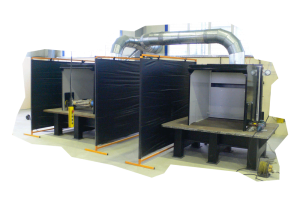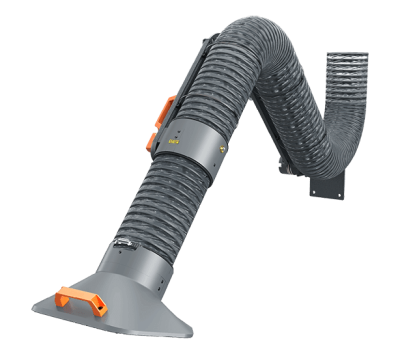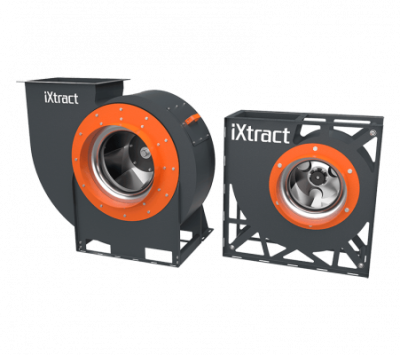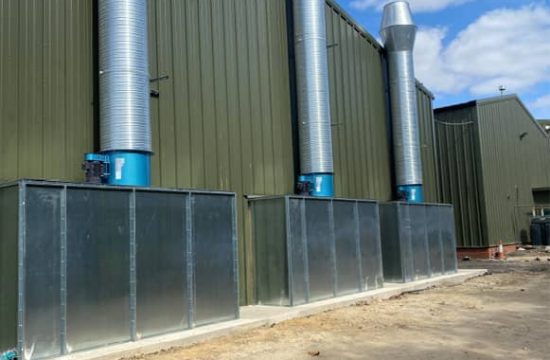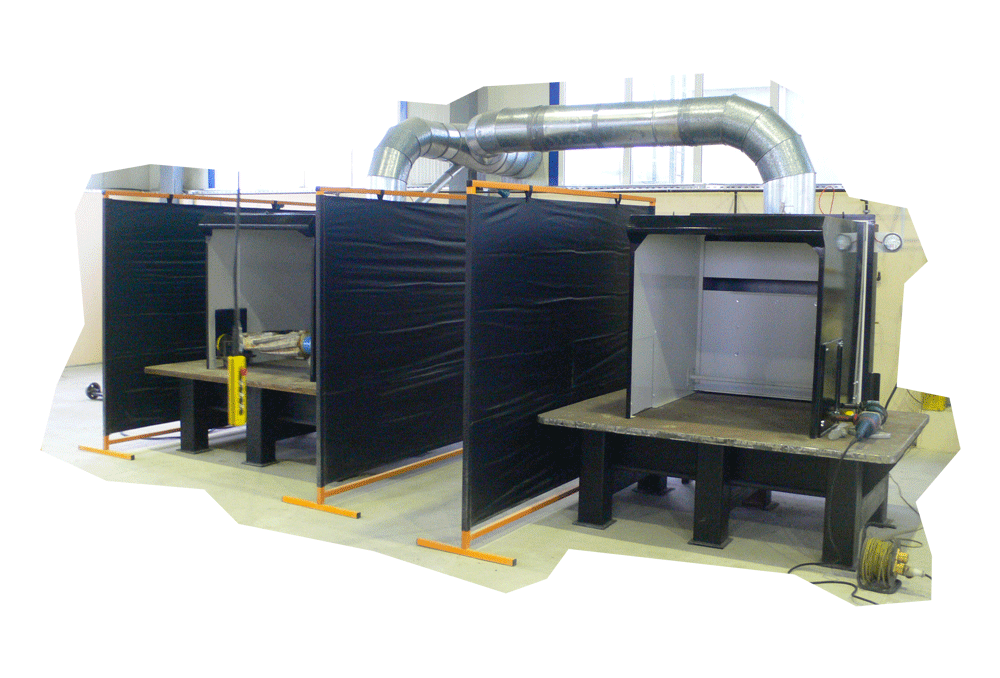Full Description
Not Sure What Spray Booth Extraction System You Need?
With several options available, selecting the ideal spray booth extraction solution for your business can be a daunting task. It's crucial to have a system that meets safety standards and performs effectively, so our experts are here to ensure you don't have to worry. We'll take the stress away and guide you through the process.
If you're unsure which spray booth extraction system is best for your business, contact our team today. We'll assess your specific requirements and recommend a reliable, cost-effective solution designed to keep your workplace safe and compliant.
Spray Booths
A spray booth is a safe and controlled environment where paint, coatings, adhesives and other materials can be applied to surfaces. If your business handles large volumes of spray paint, you may have considered installing a spray booth extraction system. Spray booths are ideal for designing and manufacturing industrial products that need spray painting. The benefits of having a spray booth for paint fume extraction and other applications include:
- Simple and easy to maintain
- Modular system construction
- Complies with all Health and Safety Executive (HSE) guidance
- Controls safety, temperature, airflow, humidity and other crucial elements
- Ensures precise and higher-quality finishes
- Organised and efficient workflow
- Mitigates the risks of contamination
How Do Spray Booths Work?
A booth for paint fume extraction works by drawing paint-laden air through the spray booth, whereby the filter paper catches paint fumes and airborne paint droplets. The filter media is made from Andrea paper and spans the width of the spray booth. The Andrea paper is folded into a concertina form and is one, two or three layers deep, making the route traitorous.
Paint extraction units collect 80-90% of the dry overspray dust to leave the chamber behind clear of paint overspray and paint fumes.
Spray Booth Variants

A paint extraction unit can come in various sizes and be assembled as part of a modular system to meet your fume extraction requirements. Booths are manufactured in galvanised steel, double-folded for stiffness and rigidity. They offer a complete wet paint and fume extraction solution for your business. Dry filter spray booths can be supplied in various kinds to suit your range of painting processes, including:
- Bench type - These can be specified in a variety of different modular depths and widths, and feature a workbench as standard. These are ideal for smaller workpieces.
- Low-level Penums - These can be specified in a variety of different modular depths and widths; however, they are ideal for converting rooms into spray rooms.
- Extended heights - These can be specified in a variety of different modular depths and widths (typically 1-meter in-depth, as standard), however, these are taller and area ideal for taller workpieces.
- Standard Type - These can be specified in a variety of different depths and widths (typically 1 meter in depth, as standard).
Spray booths come complete with a push-button start button for each motor, whilst spray booths can be specified to feature integrated ultra-white LED lighting to illuminate the workpiece.
How Much Does a Paint Fume Extractor Cost?
The cost of a paint fume extractor can depend on several factors, such as the industry, workplace environment and the specific requirements of your business. At Auto Extract Systems, we provide various spray booth extraction solutions, from bench-type to standard spray booths. You should choose a size and variant suitable for your paint fume extraction requirements. Some businesses may require a small, basic paint fume extractor, while others are better suited to advanced solutions.
We recommend that you contact us today to hear how we can help you with paint shop fume extraction. We will listen to your requirements and suggest a paint extraction unit that suits you best. Our team will also provide a bespoke quote based on our recommendations. Contact us today to find out more about our spray booth extraction products.
Easy Maintenance
As with all safety systems, it's essential to regularly maintain the paint fume extraction system to keep it in good working condition, ensure optimal performance and protect your employees from harmful particulates leaking into the air. Maintenance is simple with our systems as part of the ongoing maintenance regime, and disposable spray booth filters only take a few minutes to replace.
What Are the Dangers of Spray Painting?
Spray painting may be a standard method for applying paint and other coatings, but it has health risks and dangers. In particular, inhaling airborne contaminants can lead to respiratory issues and other health complications. The HSE defines paints, thinners and glues as solvents or VOCs (volatile organic compounds). Tasks such as spraying, for example, in bodywork spray workshops, can generate very high exposure levels. Other dangers include skin irritation, burns, fire and explosive concerns, and allergies.
What Does the HSE State?
In the Health and Safety Executive's (HSE) ‘HSG140: Safe Use and Handling of Flammable Liquids’ guidance, it states that there should be sufficient ventilation where flammable liquids are being handled to dilute any released vapours to a safe level, below the applicable workplace exposure limit. However, where there is not sufficient ventilation, mechanical ventilation, in the form of local exhaust ventilation, is required.
HSE HSG276: Isocyanate Paint Spraying guidance states: “Isocyanate paint mist is invisible and breathing it in can cause occupational asthma.” However, Yale School of Medicine states: “If occupational asthma develops, attacks can be triggered in a variety of environments; not just by isocyanate exposure."
The HSE recommend that local exhaust ventilation (LEV) be put in place to help capture solvent fumes and overspray to help clean the air. Extracted air should be discharged to a safe place. Read the HSE’s latest guidance on spray rooms and booths here.
Health Risks Associated With Bodywork Spray Workshops
Solvents can penetrate the body when vapours and fumes are inhaled, in contact with your skin, or through solvent-contaminated workwear. Solvents can have several short-term health risks, including eye irritation, lung irritation, skin problems, and headaches, whilst long-term health risks can include dermatitis and occupational asthma. You can read more about the dangers of solvents here.
Examples of HSE Punishments for Paint Extraction Failures
When businesses don’t adequately control spray painting processes, the consequences can be severe, both for people and owners. The HSE routinely investigates workplaces to ensure companies are compliant. When visiting a site, inspectors may find issues like poor extraction procedures, faulty LEV equipment, or missing risk assessments. Failure to mitigate risk against toxic paint fumes can cause harm to people’s health, so the HSE doesn’t hesitate when taking action. The regulator often begins by issuing Improvement Notices, but if the business doesn’t improve or someone suffers harm, breaching health and safety laws can lead to fines, imprisonment or disqualification from running a company.
Below are some real examples of businesses that the HSE has punished for paint extraction failures.
- A vehicle bodyshop failed to control exposure to paint containing isocyanates, which caused a worker to develop occupational asthma. Investigators visited the premises several times and found that the company had failed to implement adequate control measures, exposing the employee to the risk of developing asthma. The business pleaded guilty to breaching the regulations and was subsequently fined £120,000 plus legal costs of £2,657. It’s a clear example of how inadequate controls and risk assessment can result in heavy financial and legal consequences.
- An automotive repair company was prosecuted after a worker died from inhaling dichloromethane while he was cleaning a paint-stripping tank. The HSE found that the employee wasn't provided with formal training for the task, instead given 'on-the-job training'. The company was fined £50,000 for breaching the regulations. This tragic outcome underscores that solvent vapours can prove fatal in the long run. When controls fail, the consequences can be catastrophic, leading to criminal charges and significant penalties.
- A utilities firm in Devon was fined after an agency worker was exposed to isocyanate in paint over several weeks. The HSE said that isocyanate is the second largest cause of occupational asthma and can also lead to dermatitis, rhinitis, conjunctivitis, and bronchitis. An investigation found that the company failed to prevent or adequately control exposure to the chemical, leading to a £4,000 fine and legal costs of £15,062.





















